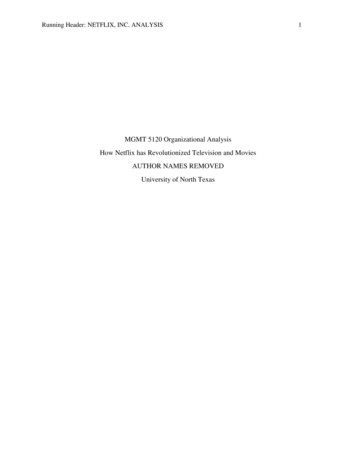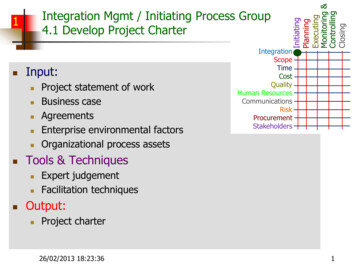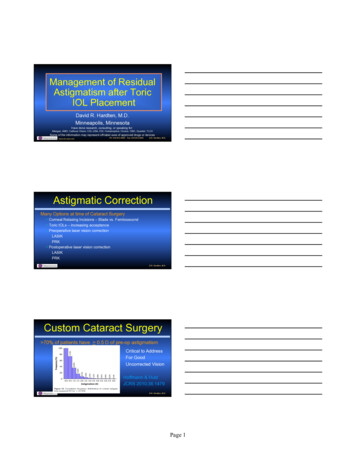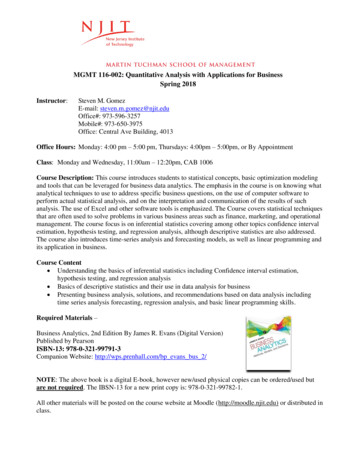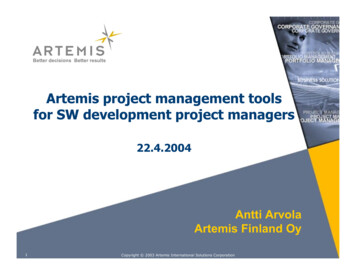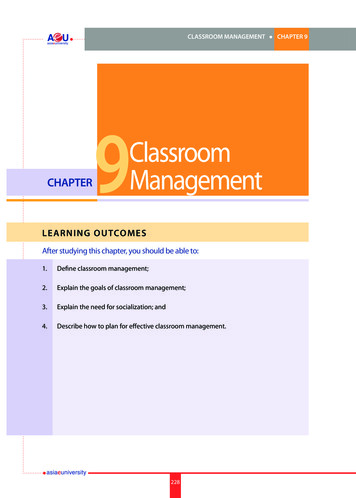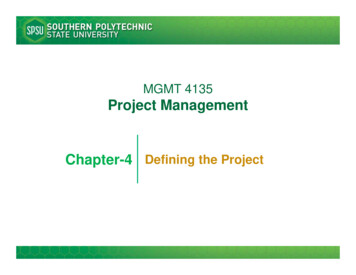
Transcription
MGMT 4135Project ManagementChapter-4 Defining the Project
Chapter-4Defining the ProjectWhere We Are Now
Chapter-4Defining the ProjectSteps for Defining the ProjectStep-1 Defining the Project ScopeStep-2 Establishing Project PrioritiesStep-3 Creating the Work Breakdown StructureStep-4 Integrating the WBS with the OrganizationStep-5 Coding the WBS for the PMISCreate Responsibility MatrixCreate The Communications plan
Chapter-4Defining the ProjectStep-1 Defining the Project Scope Project scope statement is a details description of theend result of the project. It typically includes projectobjectives, deliverables, milestones, projectspecifications, technical specifications, and limits andexclusions. Poorly defined scope will surely be the barrier to projectsuccess. Research shows that 50% of project planningissues relate back to unclear definition of scope andproject goals. Scope should be developed under the direction of theproject manager and the customer.
Chapter-4Defining the ProjectStep-1 Defining the Project Scope Project Scope is the most important document of theproject plan. Use this checklist to ensure that scopedefinition is complete:1. Project objectives: define the overall objective of theproject in order to meet your customer’s need(s).Objectives answer the questions of what, when, and howmuch.2. Deliverables: define the major deliverables or outputs overthe life cycle of the project3. Milestones: a significant project event that occurs at apoint in time; A milestone schedule shows only majorsegments of work; built using the project deliverables.
Chapter-4Defining the ProjectStep-1 Defining the Project Scope Project Scope is the most important document of theproject plan. Use this checklist to ensure that scopedefinition is complete:4. Technical requirements: Ensures proper performance ofthe end product, service, or result. These are the technicalspecifications of the end product that must be built into theplan. E.g. speed and capacity of a database or speed andaccessibility of a wireless network.5. Limits and exclusions: These statements call out thoseitems that are not in scope of the project. Without thesestatements, stakeholders can make false assumptions andput unrealistic expectations on the project team.
Chapter-4Defining the ProjectStep-1 Defining the Project Scope Project Scope is the most important document of theproject plan. Use this checklist to ensure that scopedefinition is complete:6. Review with the customer: Completed scope statementand checklist should be reviewed with your customer. Theproject manager seeks understanding and an agreementwith the customer that the scope is correctly stated. Theproject manager also seeks the customer’s confirmationthat the timing/schedule, budget, and key accomplishmentsare also defined accurately.
Chapter-4Defining the ProjectStep-1 Defining the Project Scope Statements of Work (or SOW) is a project scope supplied bya vendor who will be performing project work for theperforming organization. It is similar to an internal ScopeStatement but is geared more towards what the vendor will bedoing to achieve the goals of the project. Project Charters officially declares the project and authorizesthe project manager to initiate and take charge of the project.It is a brief scope statement that may include such items asknown risks, customer needs, spending limits, general datesof milestones and delivery of the end product, result, orsolution, and may even name some specific resources to bepart of the project team.
Chapter-4Defining the ProjectStep-1 Defining the Project Scope Scope Creep is a term that describes the tendency for theproject scope to expand over time. Changing requirements,specifications, and priorities are the main culprits. Scope Creep can be prevented by carefully writing the scopestatement with as much detail as possible. Scope statementsthat are written too broadly open the door for scopeexpansion. Scope Creep adds risk, cost, and schedule delays in mostinstances. Scope Creep should be avoided and watched-for by theproject manager.
Chapter-4Defining the ProjectStep-1 Defining the Project Scope Change Control: if the project scope needs to change, achange control process should be in place that logs all projectchanges. These logs should include the impact of the changeand those responsible for approving or rejecting the change. Project changes are one of the most complex and frustratingissues that project managers must often deal with.
Chapter-4Defining the ProjectStep-2 Establishing Project Priorities Developing a decision priority matrix before the project beginsis useful in that it provides clear priorities with the customer(s)and top management. It creates shared expectations andavoid misunderstandings, It is essential to the planning process where adjustments areoften made to scope, schedule, and budget. Priority Matrix Figure 4.2:1. Constrain: In this case, performance is fixed which means that theproject must ensure that the performance of the solution meetsperformance parameters, without variance2. Enhance: Time should be enhanced to shorten the time to market forthe product. In doing so,3. Accept: going over budget is acceptable although is neverdesirable.
Chapter-4Defining the ProjectStep-2 Establishing Project Priorities Priorities change over the life cycle of the project. Goingback to 4.2, it shows that cost overruns are in an “accepted”state. However, 4 months into the project, top managementcould easily emphasize cost containment, thus changing thiscriteria to a “constraint,” which is now disallowing overruns.
Chapter-4Defining the ProjectStep-3 Creating a WBS Work Breakdown Structure (WBS) is a map of the project.This is the process of subdividing project deliverables andwork into smaller packages. This is a hierarchicaldecomposition of the work to be executed by the project team. Each descending level of the WBS represents a more detaileddefinition of the project deliverable. The actual planned work is found at the lowest level of nodesin the WBS – these are called work packages. Organizationunits and/or individuals are assigned responsibility forexecuting all work packages.
Chapter-4Defining the ProjectStep-3 Creating a WBS The importance of the WBS is that it: Is a Primary tool for controlling scope Is always based on deliverables rather than the tasks thatproduce the deliverables. It defines WHAT will be delivered, NOT HOW. Assists in coordinating many parts of the project. Problems are quickly addressed because the structureintegrates work and responsibility.
Chapter-4Defining the ProjectStep-3 Creating a WBS How WBS Helps the Project Manager Is a Primary tool for controlling scope Each WBS node requires a time and cost estimate which ishelpful in creating the schedule and a budget It is used to aggregate the estimated costs of the workpackages into the upper parts of the WBS. And because work packages are assigned to a unit orindividual, the project manager is aware of the resourcesthat will be utilized for project work.
Chapter-4Defining the ProjectStep-3 Creating a WBSAnimatedComputer Game1.1Story Line1.2Drawings1.1.11.2.1 CharacterCharacter ndappearance1.1.31.2.3PlotMachines1.1.41.2.4Game leration2.1.1User Manual1.3.2Action Rules2.1.2Online Help1.3.3Game ledgebase
Chapter-4Defining the ProjectStep-3 Creating a 4.4aNoise TypesTemperatureRangesLight TypesFirearm Types1.2.4.3b1.2.4.3bLight ColorsFirearm Affects1.2.4.1bNoise Affects1.2.4.2bTemperatureAffects1.2.4.4cLight Affects
Chapter-4Defining the ProjectStep-3 Creating a WBS Work Packages When the WBS cannot be decomposed any further, the lastnode is considered a work package. This is where theactivities of the project are derived. Most work packages should have a duration ofapproximately 80 hours (or 10 business days). Each package has a completion date, a cost, a resource,and usually technical specifications. Each work package should be independent of other workpackages. No work package is described in more than one subdeliverable of the WBS.
Chapter-4Defining the ProjectStep-3 Creating a WBS Work Packages Figure 4.4 on pg. 112 shows several work packages belowthe lowest level of the WBS under the sub-deliverable ofthe Hard Disk storage unit. Each work package:1.2.3.4.5.6.Defines work to be doneIdentifies how long to complete the work packageIdentifies the time-phased budget to complete the workIdentifies the resources need to complete the workIdentifies a single person responsible for the units of workIdentifies monitoring points for measuring progress
Chapter-4Defining the ProjectStep-3 Creating a WBS
Chapter-4Defining the ProjectStep-3 Creating a WBS WBS development should take advantage of previous similarprojects. WBS development is a group effort under the direction of theproject manager and other organizational management. WBS structures should not follow the organization structure asit will focus more on the organizational function rather than onthe project output of deliverables. WBS should be output oriented with concentration on concretedeliverables.
Chapter-4Defining the ProjectStep-4 Integrating WBS with Organization WBS links the organizational units who will be performing thework. The outcome of this process is the organizationbreakdown structure (OBS). The OBS: Provides a framework to summarizeorganization work unit performance. Identifies organization units responsiblefor work packages. Ties the organizational unitsto cost control accounts
Chapter-4Defining the ProjectStep-4 Integrating WBS with Organization The OBS assigns the work packages to an organization unit thatwill be responsible for the work packages that fall within the samecost account. A Cost Account governs the cost for all types of work. Whenwork packages are categorized by type of work, all the costs forthose types of work packages are aggregated up to a costaccount. E.g.: Software development, Hardware build, Testing –each of these could contain one or several work packages. Acost account will be assigned to each of these work types. A Cost Account is a control point of one or more work packagesthat are used to plan, schedule, and control the project. The sum of all project cost accounts represents the totalcost of the project.
Chapter-4Defining the ProjectStep-4 Integrating WBS with Organization
Chapter-4Defining the ProjectStep-5 Coding the WBS for the PMIS PMIS is the project management information system. The textsuggests that coding the WBS and the account systems arefound in the information system. Codes define each level of the WBS; subsequent layers of theWBS use the parent code followed by a “dot” code. In theexample on the previous slide, 1.4 represents the“Microprocessor unit.” 1.4.1 and 1.4.2 further defines thedeliverables for the unit. 1.4.11 is yet a further decomposition ofthe unit. Coding the WBS is uniquely structured by the performingorganization. If the organization does not have a specific WBScoding process, the project team will typically follow its ownformat.
Chapter-4Defining the ProjectStep-5 Coding the WBS for the PMIS Coding the WBS work packages is also a personal preference.There are no industry standards, per se, regarding best practiceson how to code WBS nodes and work packages. Step-1 Defining the Project Scope Step-2 Establishing Project Priorities Step-3 Creating the Work Breakdown Structure Step-4 Integrating the WBS with the Organization Step-5 Coding the WBS for the PMISCreate Responsibility MatrixCreate The Communications plan
Chapter-4Defining the ProjectCreate the Responsibility Matrix A Responsibility Matrix summarizes tasks to be worked andwho is responsible for that project work. Typically used for smaller less complex projects. The Matrix defines the responsibility of each resource orresource group defined. Figure 4.6 assigns each resource a code R (responsible)or S (supports/assists). R responsible for coordinating the efforts of making surethat the task is completed either by that resource or byothers who may be assigned S support/assist those marked as responsible.
Chapter-4Defining the ProjectCreate the Responsibility Matrix Richard is responsible for identifying target customers. Danand Linda will support and assist Richard for this task. The Responsibility Matrix provides a means for all projectmembers to view and agree/disagree the assignment ofresponsibilities. Figure 4.7 takes a different approach on developing aResponsibility Matrix. This Matrix uses number 1 thru 5 andincludes a legend of what each code designates.Design organization is responsible for the Architectural designof the project, as indicated by the 1 in the Matrix. TheDevelopment and Testing organizations will support the Designunit with the Architectural design, as indicated by the 2 in theMatrix. QA and Manufacturing units will act as consultants.
Chapter-4Defining the ProjectCreate the Communication Plan The Communication Plan is created very early in the project. Itis especially important that the communications plan be in placeonce the project deliverables and work have been clearly defined. A well defined Communication Plan ensures the customer, teammembers, and other stakeholders will be provided with theinformation they need (and when they need it) in order to do theirjobs. The communication plan is a key component in coordinatingand tracking project schedules, issues, risks, and action items. Itmaps out the flow of information to specific recipients and atspecified frequencies.
Chapter-4Defining the ProjectCreate the Communication Plan The Communication Plan includes a Stakeholder Analysis. Thisidentifies different groups or people who need information to eithermake decisions or contribute to the project. Another element of the communications plan is the informationneeds. Certain people at various levels in the organization needsummary information while others require full details. Thecommunication plan maps out who gets what. Sources of information are critical in identifying what types ofinformation is available for dissemination. Disseminating modes describes the vehicle in which theinformation will be sent. Responsibility and timing describes who is responsible fordisseminations and the frequency in which the communication willoccur.
Chapter-4Defining the ProjectChapter-4 Key terms:Cost account, 113Project charter, 105Scope statement, 105Milestone, 103Responsibility matrix, 116Work breakdown structure(WBS), 108Organization breakdownstructure (OBS), 113Scope creep, 105Work package, 110Priority matrix, 106
Most work packages should have a duration of approximately 80 hours (or 10 business days). Each package has a completion date, a cost, a resource, and usually technical specifications. Each work package should be independent of other work packages. No work package is described in more than one sub-deliverable of the WBS.
